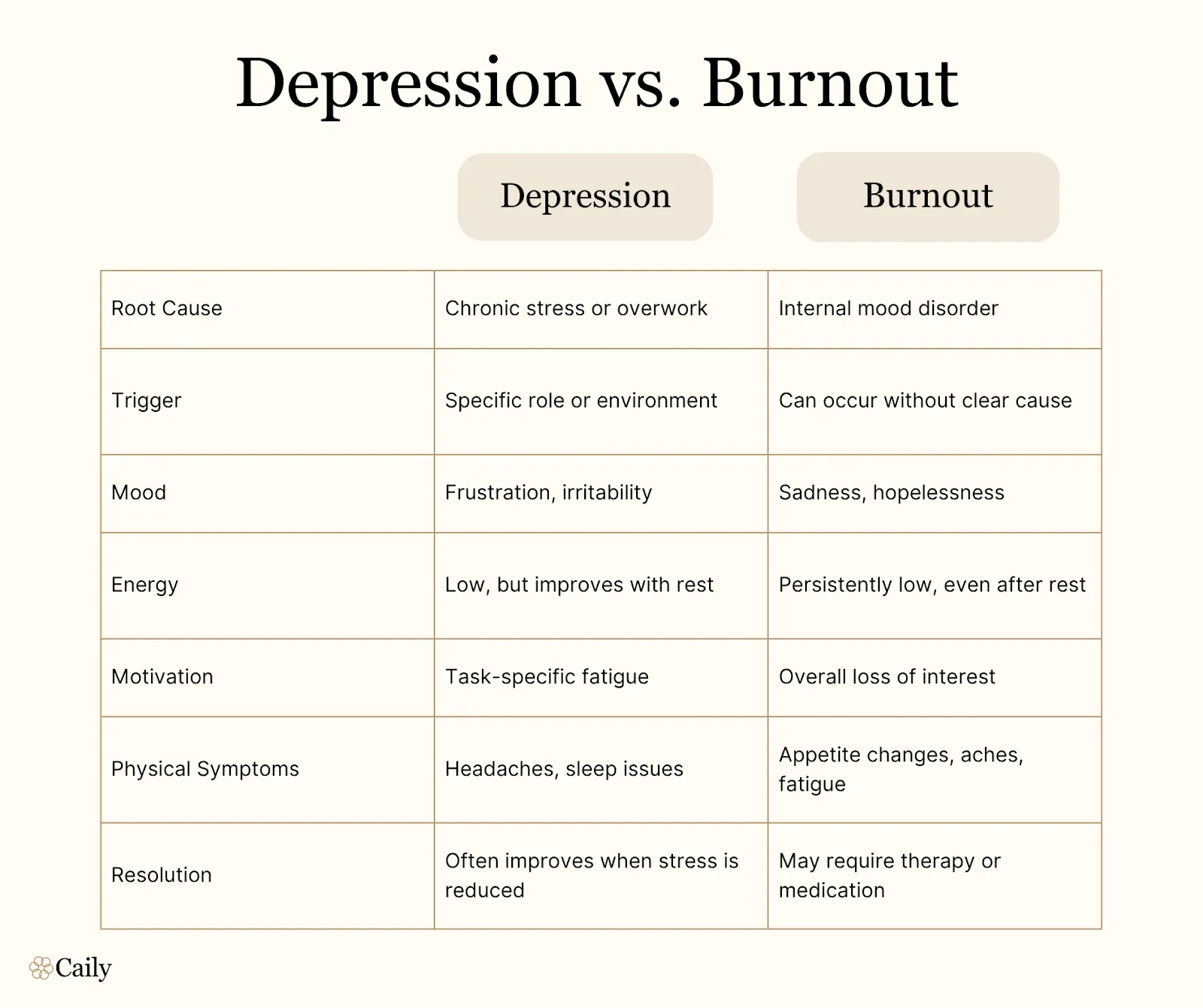Burnout vs Depression: Understanding The Difference

When you're overwhelmed, exhausted, or emotionally drained, it can be hard to tell what's going on. Are you burnt out from responsibilities, or are you experiencing depression? The two can look similar on the surface, but have very different causes and recovery paths.
This guide breaks down the differences between burnout vs depression, explains overlapping symptoms, and offers practical advice for healing and prevention, especially for caregivers and those in high-stress roles.
What is burnout?
Burnout is more than just feeling tired or unmotivated. It's a state of chronic physical and emotional exhaustion that builds over time, especially in caregiving roles or demanding work environments. While many people use the word casually, true burnout can significantly affect your mental and physical well-being.
Burnout happens when prolonged stress outweighs your ability to cope. It's common among professionals, parents, and caregivers who consistently push themselves without adequate rest or support. It’s not a medical diagnosis, but it's recognized as a serious condition that can lead to longer-term mental health issues if left unaddressed.
Burnout often develops slowly. You might notice it as growing frustration, feeling drained even after sleeping, or being emotionally numb to things that once mattered.
Burnout vs. Stress: What’s the difference?
While burnout often stems from prolonged or unmanaged stress, the two are not the same. Stress is typically a short-term response to pressure; it might leave you feeling anxious, wired, or overwhelmed, but you can usually still function. Burnout, on the other hand, develops over time and leads to emotional numbness, profound exhaustion, and a sense of hopelessness. It’s not just that you’re tired, it’s that you no longer see a way forward or feel incapable of engaging at all.
As the World Health Organization notes, burnout is characterized by “feelings of energy depletion or exhaustion, increased mental distance from one’s job, or feelings of negativism and reduced professional efficacy.” Unlike stress, burnout doesn’t just sap your energy; it can erode your identity, motivation, and belief that things can improve.
Symptoms of Burnout You Shouldn’t Ignore
Recognizing the symptoms of burnout is the first step toward recovery. These often include:
- Chronic fatigue
- Increased irritability or detachment
- Trouble concentrating
- Cynicism or loss of motivation
- Feeling ineffective, no matter how hard you try
- Trouble sleeping
- Changes in appetite
- Social withdrawal
- Proscrastination
- Absenteeism
- Substance use
So, what does burnout feel like? It can feel like running on empty. You're going through the motions, but you're mentally and emotionally checked out. Small tasks feel enormous. Joy feels distant. Your fuse is short, and rest never feels restorative.
What is depression?
Mayo Clinic defines depression as “a mood disorder that causes a persistent feeling of sadness and loss of interest. Also called major depressive disorder or clinical depression, it affects how you feel, think and behave and can lead to a variety of emotional and physical problems.”
While burnout is tied to external stress and overexertion, depression is a diagnosable mental health condition that affects how you think, feel, and function. It’s important to distinguish the two because the treatment paths are different.
Understanding Depression Beyond Sadness
Depression isn’t just “feeling sad.” It’s a pervasive condition that can interfere with your ability to enjoy life, maintain relationships, or complete everyday tasks. Depression can affect sleep, appetite, energy levels, and self-worth. Other symptoms include:
- Ongoing sadness, emptiness, or hopelessness
- Irritability or anger over minor issues
- Loss of interest in hobbies, sex, or daily activities
- Trouble sleeping or sleeping too much
- Low energy, with small tasks feeling overwhelming
- Changes in appetite or weight
- Feeling anxious or restless
- Slowed speech, movement, or thinking
- Excessive guilt or self-blame
- Difficulty focusing, remembering, or making decisions
- Thoughts of death or suicide
- Unexplained aches, like headaches or back pain
Types of Depression, Including High-Functioning Depression
There are several types of depression, including:
- Major Depression: Characterized by persistent sadness, lack of interest in activities, and significant disruptions in sleep, appetite, and energy.
- Dysthymia (Persistent Depressive Disorder): A milder but long-lasting form of depression. Symptoms can linger for years and may feel like your “normal.”
- High Functioning Depression: Not an official diagnosis, but often used to describe people who appear to be managing life, working, parenting, or caregiving, while silently struggling. This version is particularly dangerous because it can go unnoticed for a long time.
Should you take a depression test?
If you’re unsure whether you’re burned out or dealing with depression, a depression test can be a helpful tool. These self-assessments don’t provide a diagnosis, but they can offer insight into your symptoms and prompt you to seek support. If you're consistently scoring high on these tests, it's time to talk to a professional.
Burnout vs Depression: Core Differences and Shared Symptoms
Burnout and depression can look similar; fatigue, irritability, and withdrawal are common in both. But they stem from different causes and require different approaches to healing. Understanding the root cause is key: burnout usually improves when stressors are removed or managed, while depression may persist even when your environment is supportive. Getting the distinction right helps ensure you get the right kind of help.
Overlapping Signs That Can Be Confusing
Some symptoms blur the line between depression vs burnout, making it hard to pinpoint what you’re dealing with:
- Persistent fatigue or low energy: You feel physically and mentally drained, no matter how much rest you get.
- Lack of motivation: Things you once cared about feel pointless or overwhelming.
- Difficulty concentrating: You struggle to focus, follow through on tasks, or make decisions.
- Emotional numbness: Instead of feeling stressed or sad, you might feel nothing at all, like you’ve shut down inside.
- Isolation from friends and family: Socializing feels like too much effort, or you feel detached even when you're around others.
Because these symptoms overlap, it’s easy to misread one for the other. But context matters. Are you overwhelmed by caregiving, deadlines, or a lack of support? That points toward burnout. Are you feeling this way regardless of external circumstances, or struggling to feel anything at all, even with rest or breaks? That may signal depression.
Both deserve attention and care, but understanding which you’re facing can make a big difference in how you heal.

Depression vs Burnout in Caregivers
Caregivers are especially vulnerable to both. Many ask: what is a common sign of caregiver burnout? A key sign is emotional exhaustion paired with a growing sense of resentment or guilt. You may love the person you're supporting, but feel increasingly detached or overwhelmed.
If caregiving responsibilities leave you physically drained, emotionally numb, and mentally scattered, it may be more than just tiredness; burnout has likely set in. To learn more about the relationship between caregiving and burnout, read our blog, Caregiver Burnout’s Hidden Symptoms.
Recovery Tips: How to Heal from Burnout or Depression
Whether you’re experiencing burnout, depression, or both, healing is possible. But the approach must be tailored to what you’re going through. How to recover from burnout starts with permission to pause, reassess, and prioritize your own health.
Rest
Physical and mental rest are non-negotiable. When you're overwhelmed or emotionally worn down, your body and brain need recovery time, just like they would after an injury. This might mean more sleep, but it also means stepping away from tasks that deplete you, even briefly. Try incorporating short breaks throughout the day, five minutes of quiet, a short walk, or simply lying down with no screens.
Routines
Structure can be comforting when it feels supportive, not rigid or overwhelming. After a period of burnout or depression, daily routines may have fallen apart. Start slowly. Reintroduce simple rhythms: a consistent wake-up time, regular meals, or a calming wind-down ritual at night.
Boundaries
When you’re emotionally exhausted, protecting your time and energy is essential. That may mean saying no to social obligations, stepping back from non-essential responsibilities, or being honest with others about what you can realistically handle.
Caregiving support tools
If you're a caregiver or simply juggling too many roles, it's easy to reach a point of burnout without even realizing it. Platforms like Caily are designed to help by organizing care tasks, sharing responsibilities with others in your circle, and creating a space where communication and planning are simplified.
Managing and Treating Depression
If you’re experiencing symptoms of depression, it’s important to seek help, especially if these symptoms have lasted more than two weeks. Depression isn’t just something you “snap out of.” It’s a real medical condition that deserves compassionate treatment. You don’t have to wait until things feel unmanageable to get support. Here are the most effective forms of treatment:
- Therapy: Talk therapy can make a significant difference. Modalities like Cognitive Behavioral Therapy (CBT) help you identify negative thought patterns and build healthier ways of thinking and coping. Other forms of therapy, like interpersonal therapy, psychodynamic therapy, or EMDR, can also be helpful, depending on your needs.
- Lifestyle shifts: Mental and physical health are deeply connected. Small changes, like going for a daily walk, improving your sleep hygiene, eating nourishing meals, or spending time outdoors, can support emotional healing. While these changes don’t replace therapy or medical treatment, they are valuable tools that help your brain and body regain balance.
- Medical support: For many people, antidepressants can be a helpful part of recovery. They’re beneficial if depression is interfering with daily functioning or if therapy alone hasn’t brought enough relief. Medication can help regulate mood and restore your ability to engage with the world more fully. If you’re unsure about taking medication, speak with a healthcare provider you trust to weigh the pros and cons.
Knowing When to Get Help
If your symptoms are impacting your daily life, whether it’s work, caregiving, or relationships, it’s time to talk to someone. Reach out to a therapist, counselor, or your primary care provider. If you're having thoughts of self-harm, seek immediate help from a crisis line or emergency services.
How to Avoid Burnout and Build Resilience
Preventing burnout is about showing up for yourself consistently. Building resilience comes from daily habits like grounding routines, short bursts of physical activity, meaningful connections, scheduled breaks, and simple reflection practices. Even the smallest acts of self-respect, like pausing for a breath or saying no when needed, create a lasting impact over time.
You’re Not Alone
Burnout and depression can feel isolating, but you’re not meant to face them alone. Whether you're caring for someone else or simply carrying too much, your well-being matters just as much as anyone else’s. Tools like Caily are designed to ease the burden by helping you stay organized, delegate responsibilities, and stay emotionally connected with others.
If you're struggling, reaching out to a therapist can be a powerful step. Resources like Psychology Today’s therapist finder, Open Path Collective for affordable therapy, or the 988 Suicide & Crisis Lifeline are available when you need support. Healing starts with knowing you're not alone, and that support, community, and tools are here to help you take the next step.

Frequently Asked Questions About Burnout vs. Depression
What does burnout feel like?
It often feels like emotional and physical exhaustion, mental fog, irritability, and a sense of detachment from your responsibilities or the people around you.
What is a common sign of caregiver burnout?
Emotional fatigue combined with guilt or resentment toward caregiving duties is a common sign. You may also feel numb or short-tempered even with loved ones.
How to recover from burnout?
Rest, set boundaries, lean on tools like Caily, and make time for routines that support your health. Recovery takes consistency, not perfection.
How to avoid burnout?
Build in rest, delegate tasks, maintain boundaries, and prioritize your needs daily. Use support platforms to stay organized and supported.
What’s the difference between depression vs burnout?
Burnout stems from prolonged stress in specific roles. Depression is a medical condition that affects all areas of life. They share symptoms but differ in root cause and treatment.
Is high-functioning depression the same as burnout?
No. High-functioning depression involves chronic internal distress, even when life appears “normal.” Burnout is tied to stress overload and usually improves with rest and reduced demands.

Get Started Now
Enjoy full access to everything Caily offers, from medication tracking to shared schedules and daily check-ins. See how much easier caregiving can be when everything is coordinated in one place.
Start your free trial
